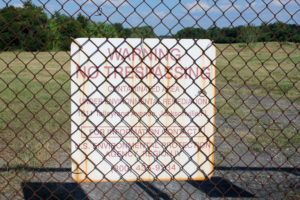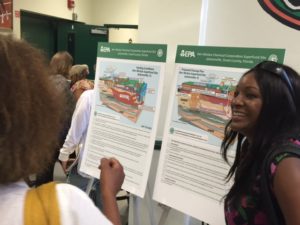
Wynetta Wright remembers eating fresh octopus and fish straight out of the river as a kid growing up in Jacksonville’s Eastside neighborhood. Her uncle worked at the docks on Tallyrand Avenue and her aunt took her there to get fresh seafood right next to a business called Wilson & Toomer Fertilizer Co., later Kerr-McGee Chemical Company. What they didn’t know was that herbicides, pesticides and fertilizer had been made on the site since the late 1800s, and in the days before environmental awareness, dangerous chemicals had leached into the soil, the rivers and the sediment all around the property.
Today the property is a “Superfund” site, meaning the federal government coordinates liability and clean-up, and although it is fenced off, there are businesses and homes all around it. The Environmental Protection Agency was in town last Wednesday to show its clean-up plan to city officials and residents, and some are crediting Wright for making it happen.
“She has been working feverishly and tirelessly for this for 20 years,” said Teena Anderson, who works with Wright on environmental issues in the neighborhood.
The 31-acre site is now empty but tests show chemicals, including pesticides and arsenic, are present in the soil, the groundwater and sediment in the St. Johns River and Deer Creek in levels the EPA says “pose a threat to human health and the environment.” Kerr-McGee ceased manufacturing in 1978 and demolished the buildings except for two foundations. It then moved the property into a corporation called Tronox, which declared bankruptcy, leaving the state and federal government with the problem of clean-up. A settlement was later reached requiring Tronox to pay $5 Billion toward clean-up in sites all over the country.

There is too much contaminated soil to haul it all away, said Tasha Lewis of the Multistate Environmental Response Trust, although the worst of it will be removed. To remove all the soil would take “25 trucks running six days a week for two years,” said Lewis.
A federal bankruptcy judge assigned ownership and management of the property to the trust, which hired AECOM, a national environmental consulting firm with Jacksonville offices, to develop a plan.
Currently, as rain water seeps into the soil it leaches contaminants into the ground water, some of which then flows into the St. Johns River and Deer Creek, which runs south of the property. Contamination has been found 45 feet down into the property, but not far enough to reach the city’s drinking water.
The land surface will be capped with fabric, clay, new soil and vegetation to prevent rain water from continuing to wash the chemicals into the ground and waterways. A bulkhead will be built in the St. Johns to keep contaminants from further entering the river.
Some of the soil will be mixed with a cement-like product to stabilize it, said Amy Mixon of AECOM. Then the ground water that flows through it will be pumped to the surface and treated on site.
One thing not included in the proposed $69 Million plan is clean-up for Deer Creek, which many residents fish out of, said Anderson. But Robenson Joseph, EPA Project Manager, said that will happen after this phase is complete.

In the meantime, Deer Creek is still a concern for members of the Eastside Environmental Council, a group Wright founded in 2004 to educated Eastside residents about environmental problems in the area and about healthy living choices.
The neighborhood is east of downtown and is defined as zip code 32206. JaxPort is located there, along with other port businesses like Toyota, Crowley Marine and a CSX yard. It was home to heavy manufacturing and low-income housing for nearly a century. Now it’s mostly light industrial but contamination from earlier days remains. There are 1,200 contaminated sites, according to the group and residents have more health problems, like asthma, than other parts of the city, according to county Department of Health statistics.
Eighty percent of the residents are African American, and 47% fall below the federal poverty level. There are no grocery stores, no pharmacies, and no gas stations in the community.
“We have kids who don’t know what fresh vegetables look like,” Wright said in a video posted on the group’s website. Fish from the river and three creeks that run through the neighborhood – Deer, Hogan, and Long Branch – are an important food source to the community, but posted signs warn residents not to eat the fish.
“The river is the lifeblood of the community,” said Wright in the video, adding that it brings economic development and food. “My hope for the future of the river is that we bring it back … .”
The EPA is seeking public comment until October 12, 2016 by mail or email to Robensen Joseph, EPA Remedial Project Manager, Atlanta Federal Center, 61 Forsyth Street SW, Atlanta, GA 30303 or joseph.robenson@epa.gov.


2 Responses
Mildred A.
Hello Lisa,
Another excellent and informative report. I hope it can be published in several publications. Surely hope it will bring some help to those communities victimized by this pollution.
All the best .
M.A.
editor@floridafieldnotes.com
Thank you so much for your feedback and support. I’m often inspired by the people I run across while covering a story. Thanks again! Lisa